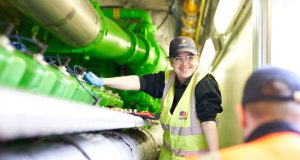 DIGITAL SOLUTIONS PROVIDER’S VIEW
DIGITAL SOLUTIONS PROVIDER’S VIEW
GIAMPIERO FRISIO,
HEAD OF ABB’S SMART POWER BUSINESS
COP26 represents an exciting opportunity for facilities managers, particularly if, as we suspect, new sustainability objectives are agreed that will accelerate action to drive energy efficiencies and further reduce CO2 emissions. Setting more ambitious targets, or applying existing standards more universally, will encourage all of us to play our part to protect our planet for future generations.
FMs across the globe are already starting to realise the value that digitalisation brings, as a tool to fight climate change and manage energy efficiencies across the built environment.
Commercial and industrial building FMs have a pivotal role to play in reducing energy use and carbon emissions. To do this well though, they need to embrace innovative digital solutions that provide intelligent insight on how facilities are performing and identify where potential energy and cost saving improvements can be made. This is where digitalisation comes into its own, providing a golden thread to pull existing sustainability solutions together into one coherent, controllable system.
Digitalisation supports FM decision-making by providing a comprehensive view of energy consumption and asset condition as well as external variables such as weather forecasts and energy costs. A dashboard of this data highlights energy inefficiencies and key performance gaps and will help FMs analyse and monitor the journey to achieve improvements in these metrics going forward.
To get the most from digitalisation and the potential for carbon savings, there are a few key things FMs should be aware of. Firstly, any digital solution should be applied to the whole system. Monitoring multiple sites, parameters and assets separately is not as effective as bringing these elements together into one integrated dashboard to better manage the complexities of energy demand and to scale up the energy savings achievable.
Secondly, digitalisation yields higher returns when coupled with Internet of Things (IoT) devices. Of course, digital solutions on their own can support baselining and help to identify where improvements can be made, but value creation happens when digital and hardware unite. This comprehensive approach has been used to great effect in our own Frosinone factory in Italy, where we have delivered 30 per cent energy savings and created a blueprint for other energy service companies to follow.
To future proof facilities, FMs can also stagger their digital journey, taking a step-by-step approach to implementing a fully digital solution. For example, retrofitting sensors in phases will allow FMs to make a start on increasing energy efficiencies, saving costs and reducing emissions as they build in extra functionality.
It is also worth noting that digitalisation can increase the life span of key devices, including breakers, switches and motor starters, as it improves asset maintenance and monitoring. It is also a big business benefit as there is less downtime and unplanned maintenance and FMs benefit from lower capex on replacement equipment.
Ultimately digitalisation and the ability to keep assets up and running for longer are strictly related: improved digitisation means FMs are better prepared for the expected and the unexpected.
By embracing the potential of digitalisation, FMs can play a key role in the fight against climate change. With the right information at their fingertips, they can also make huge strides towards delivering a net zero future for us all.
FMJ & Andrea Temporiti, Head of Digital for ABB Electrification will present a webinar: Data – the human element in a sustainable future on 28 October at 11am. Register here: https://bit.ly/3lQswUW
 FM SERVICES SUPPLIER’S VIEW
FM SERVICES SUPPLIER’S VIEW
KATH FONTANA,
MANAGING DIRECTOR OF MITIE PROJECTS
COP26 offers an opportunity for countries around the world to share ideas, plans and best practice on how they will reach net zero by 2050. While the UK has already taken a major step by committing to cut its carbon emissions by 78 per cent by 2035, it’s still missing a plan on how it will decarbonise the built environment, which accounts for a significant part of the nation’s carbon footprint.
Decarbonising the built environment is not only a challenge for Government, but businesses too. This is why we hope that this COP will be an opportunity for countries to discuss how they are planning to tackle this challenge and, more importantly, declare their support for businesses decarbonising their operations and estates too.
We know that reaching net zero for the built environment is not something any business can do alone – customers, FMs, landlords and the public sector must all come together. Our first-hand experience as facilities management experts, with significant building management and energy expertise, enables us to advise which solutions are best suited to which buildings. And our operational focus means we know the challenges that organisations face when rolling out these initiatives.
Customer demand for new infrastructure to generate renewable power, such as solar panels and battery storage, and for new green energy contracts is high. With expertise in these areas, we’re playing an instrumental role in supporting our customers in tackling climate change.
However, when it comes to becoming truly net zero, focusing on renewable energy is not enough, businesses will also have to face the challenge of replacing gas heating systems at their sites. Installing solutions, such as ground and air source heat pumps, often have high upfront costs, meaning that without an adequate budget to cover these costs or access to government funding, many organisations may need to either slow or stop their journey to a net zero estate.
Even organisations with the CAPEX budget to invest in heat pumps may still struggle to justify the expense due to large OPEX costs. The reason for this is that gas is significantly cheaper than electricity, in part due to the Climate Change Levy for gas being significantly lower than for electricity. This may put businesses in a difficult position of having both high upfront costs and increased energy bills – with operational and capital budgets often managed separately, many organisations find that they simply can’t cover the additional costs of switching to green electricity to heat their sites.
Our hope for COP26, and beyond, is that the UK Government offers more support for businesses trying to decarbonise their operations, helping them to overcome challenges like these. This could be done by providing funding to help businesses make green capital investments, as well as transferring the Climate Change Levy from carbon emitting gas to clean electricity to encourage more businesses to decarbonise their power.
All these financial initiatives are essential for decarbonising the built environment. And while they may seem particular to the UK, financial considerations are roadblocks for businesses in every country. This is why it’s important that this year’s COP is used as an opportunity to learn what other nations are doing to overcome these challenges and drive net zero among businesses. These lessons, alongside the experience and expertise of FM providers and energy managers, will be key for decarbonising Britain.





